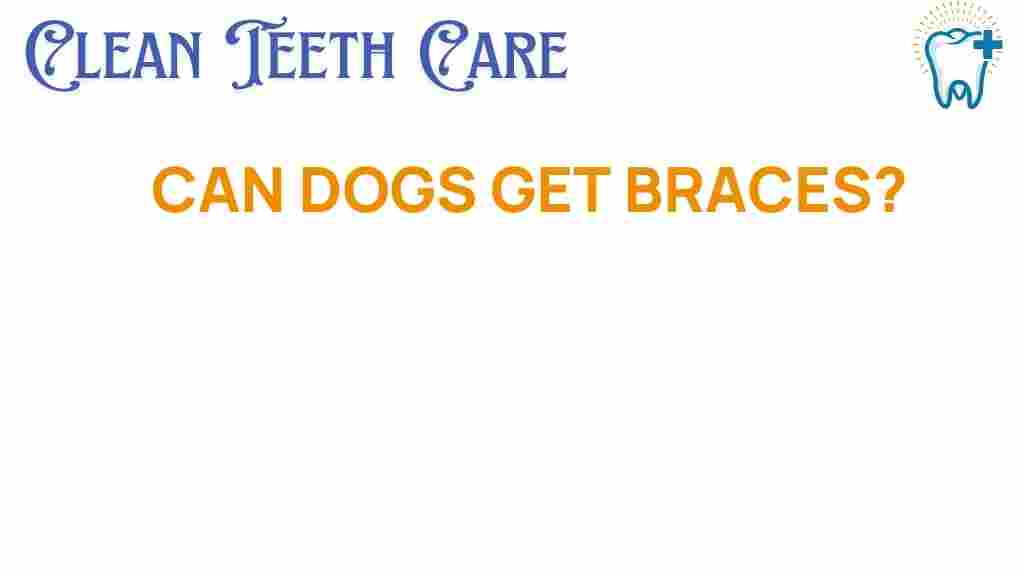Can Dogs Get Braces? Exploring Canine Orthodontics and Its Benefits
When we think of braces, our minds typically go to teenagers or adults correcting their teeth alignment. However, as pet owners become more aware of their animals’ oral hygiene, the question arises: can dogs get braces? The answer is yes! This article delves into canine orthodontics, discussing the benefits, processes, and overall importance of dental health in dogs.
Understanding Canine Orthodontics
Canine orthodontics is a field that focuses on correcting dental and jaw alignment issues in dogs. Just like humans, dogs can suffer from misaligned teeth, overbites, underbites, and other dental problems that can affect their overall health and well-being. These issues can lead to difficulty in eating, jaw pain, and even serious health problems if left untreated.
Reasons Why Dogs May Need Braces
- Overcrowding: Some dogs have too many teeth for their jaw size, leading to overcrowding.
- Misalignment: Teeth that don’t meet correctly can cause wear and tear on enamel and lead to pain.
- Jaw Deformities: Conditions like brachycephalic syndrome can cause a dog’s jaw to form improperly.
- Trauma: Injuries to the mouth can lead to shifts in teeth or jaw position.
The Benefits of Canine Orthodontics
Investing in canine orthodontics can significantly improve your dog’s quality of life. Here are some benefits:
- Improved Dental Health: Correcting alignment issues can help prevent tooth decay and gum disease.
- Enhanced Eating Habits: Properly aligned teeth make it easier for dogs to chew their food.
- Reduced Pain: Addressing misaligned teeth can alleviate discomfort and pain in the jaw.
- Better Oral Hygiene: Straight teeth are easier to clean, which promotes better oral hygiene.
- Increased Lifespan: Healthier teeth and gums can contribute to a longer, healthier life for your pet.
The Process of Getting Braces for Dogs
If you’re considering braces for your dog, here’s a step-by-step process to guide you:
1. Veterinary Consultation
The first step is to schedule a consultation with a veterinarian who specializes in veterinary treatments or canine dentistry. They will perform a thorough examination and may take X-rays to assess the dental structure.
2. Diagnosis
After the examination, the vet will diagnose any dental issues. Common conditions that might require braces include:
- Malocclusions (improper bites)
- Missing teeth
- Excessive wear on certain teeth
3. Treatment Plan
Once diagnosed, the veterinarian will create a personalized treatment plan. This may include:
- Type of braces needed
- Timeline for treatment
- Home care instructions
4. Fitting the Braces
The next step involves fitting the braces. This process may require sedation to ensure that your dog remains calm. The braces themselves are typically made of materials similar to those used for humans, but they are specially designed for the canine mouth.
5. Follow-Up Appointments
Regular follow-up appointments will be necessary to adjust the braces and monitor your dog’s progress. These visits are crucial for ensuring the braces are working as intended.
6. Post-Treatment Care
After the braces are removed, maintaining good oral hygiene is essential. Your vet may recommend a dental cleaning schedule and provide tips for home care.
Common Concerns and Troubleshooting Tips
As with any dental treatment, there can be concerns when it comes to canine orthodontics. Here are some common concerns and how to troubleshoot them:
1. Discomfort
It’s normal for dogs to experience some discomfort after getting braces. Monitor your dog closely for signs of pain and consult your vet if discomfort persists.
2. Difficulty Eating
Some dogs may struggle to eat after receiving braces. If this happens, try feeding them softer foods until they adjust. Always consult your veterinarian for advice on diet modifications.
3. Hygiene Issues
Braces can trap food particles and plaque. Regular dental care, including brushing your dog’s teeth and using dental chews, is essential. If you notice persistent bad breath or gum issues, contact your vet.
Maintaining Dental Health After Braces
Once your dog’s braces are removed, continuing to prioritize their dental health is crucial. Here are some tips to ensure long-term pet wellness:
- Regular Veterinary Check-Ups: Schedule regular veterinary visits for dental cleanings and check-ups.
- Daily Brushing: Brush your dog’s teeth daily with toothpaste formulated for pets.
- Dental Chews: Provide dental chews that help reduce plaque and tartar buildup.
- Watch Their Diet: Feed a balanced diet that supports oral health, avoiding sugary treats.
For more tips on maintaining your pet’s health, check out this comprehensive guide on pet care.
Conclusion
In conclusion, yes, dogs can get braces! Canine orthodontics is an emerging field that offers significant benefits for dogs suffering from dental misalignments. Proper treatment can enhance your dog’s quality of life, improve their oral hygiene, and contribute to their overall health and wellness. As responsible pet owners, it’s essential to stay informed about veterinary treatments and available options for ensuring our pets lead healthy and happy lives.
If you suspect your dog may benefit from braces or any other dental treatments, consult with a veterinary professional to explore the best options for your furry friend.
This article is in the category Treatments and created by CleanTeethCare Team
